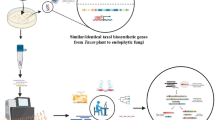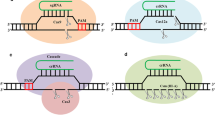Abstract
The complete sequence of the pha locus responsible for the biosynthesis of poly(hydroxyalkanoates) (PHAs) in Pseudomonas corrugata 388 was determined. As with the other known pseudomonad pha gene loci, the one in P. corrugata 388 also consists of phaC1 (1,680 bps; PHA synthase 1), phaZ (858 bp; PHA depolymerase) and phaC2 (1,683 bp; PHA synthase 2) genes. A BLAST search showed that the nucleotide sequences of these genes and the amino-acid sequences of their respective gene products are homologous to those of P. corrugata CFBP5454 and P. mediterranea CFBP5447. A putative intrinsic transcription terminator consisting of a dyad symmetry (24 bp; ΔG = −41.8 kcals) that precedes a stretch of dA residues was located in the phaC1–phaZ intergenic region. P. corrugata mutant-clones XI 32-1 and XI 32-4 were constructed in which this intergenic region was replaced with a selectable kanamycin-resistance gene. These mutant clones when grown on oleic acid for 48 h showed 4.7–to 7.0-fold increases of phaC1 and phaC2 relative expression in comparison to the initial inoculants, whereas the parental strain showed only 1.2- to 1.4-fold increases. Furthermore, in comparison to parental P. corrugata with only a few large PHA inclusion bodies, the mutants grown on oleic acid produce numerous smaller PHA granules that line the periphery of the cells. With glucose as a substrate, XI 32-1 and XI 32-4 clones produce mcl-PHA with a high content (26–31 mol%) of the mono-unsaturated 3-hydroxydodecenoate as a repeat-unit monomer. Our results show for the first time the effects of the phaC1–phaZ intergenic region on the substrate-dependent temporal expression of phaC1 and phaC2 genes, the repeat-unit composition of mcl-PHA, and the morphology of the PHA granules.






Similar content being viewed by others
References
Aldor IS, Keasling JD (2003) Process design for microbial plastic factories: metabolic engineering of polyhydroxyalkanoates. Curr Opin Biotechnol 14:475–483
Altschul SF, Madden TL, Schäffer AA, Zhang J, Zhang Z, Miller W, Lipman DJ (1997) Gapped BLAST and PSI-BLAST: a new generation of protein database search programs. Nucleic Acids Res 25:3389–3402
Ashby RA, Foglia TA, Liu C-K, Hampson JW (1998) Improved film properties of radiation-treated medium-chain-length poly(hydroxyalkanoates). Biotechnol Lett 20:1047–1052
Brandl H, Gross RA, Lenz RW, Fuller RC (1988) Pseudomonas oleovorans as a source of poly(β-hydroxyalkanoates) for potential applications as biodegradable polyesters. Appl Environ Microbiol 54:1977–1982
Catara V, Sutra L, Morineau A, Achouak W, Christen R, Gardan L (2002) Phenotypic and genomic evidence for the revision of Pseudomonas corrugata and proposal of Pseudomonas mediterranea sp nov. Int J Syst Evol Microbiol 52:1749–1758
Conte E, Catara V, Greco S, Russo M, Alicata R, Strano L, Lombardo A, Di Silvestro S, Catara A (2006) Regulation of polyhydroxyalkanoate synthases (phaC1 and phaC2) gene expression in Pseudomonas corrugata. Appl Microbiol Biotechnol 72:1054–1062
Corsaro NM, Piaz FD, Lanzetta R, Naldi T, Parrilli M (2004) Structure of Lipid A from Pseudomonas corrugata by electrospray ionization quadrupole time-of-flight tandem mass spectrometry. Rapid Commun Mass Spectrom 18:853–858
Emanuele MC, Scaloni A, Lavermicocca P, Jacobellis NS, Camoni L, Di Giorgio D, Pucci P, Paci M, Segre A, Ballio A (1998) Corpeptins, new bioactive lipodepsipeptides from cultures of Pseudomonas corrugata. FEBS Lett 433:317–320
Fett WF, Cescutti P, Wijey C (1996) Exopolysaccharides of the plant pathogens Pseudomonas corrugata and Ps. flavescens and the saprophyte Ps. chlororaphis. J Appl Bacteriol 81:181–187
Hein S, Paletta JRJ, Steinbüchel A (2002) Cloning, characterization and comparison of the Pseudomonas mendocina polyhydroxyalkanoate synthases PhaC1 and PhaC2. Appl Microbiol Biotechnol 58:229–236
Hoffmann N, Steinbüchel A, Rehm BHA (2000) Homologous functional expression of cryptic phaG from Pseudomonas oleovorans establishes the transacylase-mediated polyhydroxyalkanoate biosynthetic pathway. Appl Microbial Biotechnol 54:665–670
Kessler B, Palleroni NJ (2000) Taxonomic implications of synthesis of poly-beta-hydroxybutyrate and other poly-beta-hydroxyalkanoates by aerobic pseudomonads. Int J Syst Evol Microbiol 50:711–713
Lee EY, Choi CY (1995) Gas chromatography–mass spectrometric analysis and its application to a screening procedure for novel bacterial polyhydroxyalkanoic acids containing long chain saturated and unsaturated monomers. J Ferment Bioeng 80:408–414
Lenz RW, Marchessault RH (2005) Bacterial polyesters: biosynthesis, biodegradable plastics and biotechnology. Biomacromolecules 6:1–8
Matsusaki H, Manji S, Taguchi K, Kato M, Fukui T, Doi Y (1998) Cloning and molecular analysis of the Poly(3-hydroxybutyrate) and Poly(3-hydroxybutyrate-co-3-hydroxyalkanoate) biosynthesis genes in Pseudomonas sp. Strain 61–3. J Bacteriol 180:6459–6467
Nieto C, Fernandez-Tresguerres E, Sanchez N, Vicente M, Diaz R (1990) Cloning vectors, derived from a naturally occurring plasmid of Pseudomonas savastanoi, specifically tailored for genetic manipulations in Pseudomonas. Gene 87:145–149
Richardson JP, Greenblatt J (1996) Control of RNA chain elongation and termination. In: Neidhardt FC, Curtiss R III, Ingraham JL, Lin ECC, Low KB, Magasanik B, Reznikoff WS, Riley M, Schaechter M, Umbarger HE (eds) Escherichia coli and Salmonella: cellular and molecular biology, 2nd edn. ASM Press, Washington, DC, pp 822–848
Risse D, Beiderbeck H, Taraz K, Budzikiewicz H, Gustine D (1998) Bacterial constituents part LXXVII. Corrugatin, a lipopeptide siderophore from Pseudomonas corrugata. Z Naturforsch C 53:295–304
Scaloni A, Dalla Serra M, Amodeo P, Mannina L, Vitale RM, Segre AL, Cruciani O, Lodovichetti F, Greco ML, Fiore A, Gallo M, D’Ambrosio C, Coraiola M, Menestrina G, Graniti A, Fogliano V (2004) Structure, conformation and biological activity of a novel lipodepsipeptide from Pseudomonas corrugata: Cormycin A. Biochem J 384:25–36
Snell KD, Peoples OP (2002) Polyhydroxyalkanoate polymers and their production in transgeneic plants. Metab Eng 4:29–40
Solaiman DKY (2000) PCR cloning of Pseudomonas resinovorans polyhydroxyalkanoate biosynthesis genes and expression in Escherichia coli. Biotechnol Lett 22:789–794
Solaiman DKY (2002) Polymerase-chain-reaction-based detection of individual polyhydroxyalkanoate synthase phaC1 and phaC2 genes. Biotechnol Lett 24:245–250
Solaiman DKY, Ashby RD, Foglia TA (2000) Rapid and specific identification of medium-chain-length polyhydroxyalkanoate synthase gene by polymerase chain reaction. Appl Microbiol Biotechnol 53:690–694
Solaiman DKY, Ashby RD, Foglia TA (2002) Physiological characterization and genetic engineering of Pseudomonas corrugata for medium-chain-length polyhydroxyalkanoates synthesis from triacylglycerols. Curr Microbiol 44:189–195
Solaiman DKY, Ashby RD, Foglia TA (2003) Effect of inactivation of poly(hydroxyalkanoates) depolymerase gene on the properties of poly(hydroxyalkanoates) in Pseudomonas resinovorans. Appl Microbiol Biotechnol 62:536–543
Solaiman DKY, Catara V, Greco S (2005) Poly(hydroxyalkanoate) synthase genotype and PHA production of Pseudomonas corrugata and P. mediterranea. J Ind Microbiol Biotechnol 32:75–82
Timm A, Steinbüchel A (1992) Cloning and molecular analysis of the poly(3-hydroxyalkanoic acid) gene locus of Pseudomonas aeruginosa PAO1. Eur J Biochem 209:15–30
Timm A, Byrom D, Steinbüchel A (1990) Formation of blends of various poly(3-hydroxyalkanoic acids) by a recombinant strain of Pseudomonas oleovorans. Appl Microbiol Biotechnol 33:296–301
Zinn M, Witholt B, Egli T (2001) Occurrence, synthesis and medical application of bacterial polyhydroxyalkanoate. Adv Drug Deliv Rev 53:5–21
Acknowledgments
The expert electron-microscopic support by Peter Cooke and Guoping Bao is acknowledged. The authors thank Nicole Cross and Marshall Reed for their technical assistance. V.C. and G.L. were supported in part by funding from Ministero dell’Istruzione, dell’Università e della Ricerca Italy, PON 2000–2006, “Utilization of waste material to develop biodegradable polymers (PHA) for agriculture and agroindustry” (N°12842/01).
Author information
Authors and Affiliations
Corresponding author
Rights and permissions
About this article
Cite this article
Solaiman, D.K.Y., Ashby, R.D., Licciardello, G. et al. Genetic organization of pha gene locus affects phaC expression, poly(hydroxyalkanoate) composition and granule morphology in Pseudomonas corrugata . J Ind Microbiol Biotechnol 35, 111–120 (2008). https://doi.org/10.1007/s10295-007-0272-y
Received:
Accepted:
Published:
Issue Date:
DOI: https://doi.org/10.1007/s10295-007-0272-y




